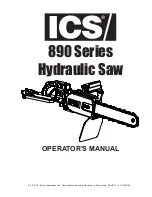
25 ENGLISH
NOTICE:
When pressing down the handle, apply
pressure in parallel with the circular saw blade.
If
a force is applied perpendicularly to the turn base or
if the pressure direction is changed during a cut, the
precision of the cut will be impaired.
1.
Remove the upper fence on the side that you are
going to tilt the carriage.
2.
Unlock the stopper pins so that the carriage can
be elevated and slid freely.
3.
Adjust the bevel angle according to the procedure
explained in the section for bevel angle adjustment.
Then tighten the grip dial.
4.
Secure the workpiece with a vise.
5.
Pull the carriage toward you fully.
6.
Switch on the tool without the circular saw blade
making any contact and wait until the circular saw blade
attains full speed.
7.
Gently lower the handle to the fully lowered posi
-
tion while applying pressure in parallel with the circular
saw blade and
push the carriage toward the guide
fences to cut the workpiece.
8.
When the cut is completed, switch off the tool and
wait until the circular saw blade has come to a com-
plete stop
before returning the circular saw blade to its
fully elevated position.
Compound cutting
Compound cutting is the process in which a bevel
angle is made at the same time in which a miter angle
is being cut on a workpiece. Compound cutting can be
performed at the angle shown in the table.
Miter angle
Bevel angle
Left and Right 0° - 45°
Left and Right 0° - 45°
When performing compound cutting, refer to the section
for press cutting, slide (push) cutting, miter cutting, and
bevel cut.
Cutting crown and cove moldings
Crown and cove moldings can be cut on a compound
miter saw with the moldings laid flat on the turn base.
There are two common types of crown moldings and
one type of cove moldings; 52/38° wall angle crown
molding, 45° wall angle crown molding and 45° wall
angle cove molding.
1
2
3
►
1.
52/38° type crown molding
2.
45° type crown
molding
3.
45° type cove molding
There are crown and cove molding joints which are
made to fit "Inside" 90° corners ((a) and (b) in the figure)
and "Outside" 90° corners ((c) and (d) in the figure.)
(a) (b)
(c) (d)
1
2
1.
Inside corner
2.
Outside corner
2
(a)
(b)
(a)
(b)
(b)
(a)
(b)
(a)
(a)
(b)
(c)
(d)
1
1.
Inside corner
2.
Outside corner
















































